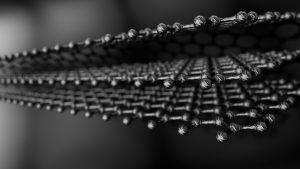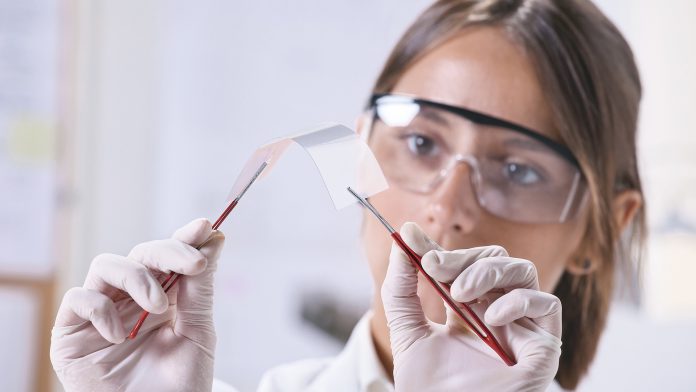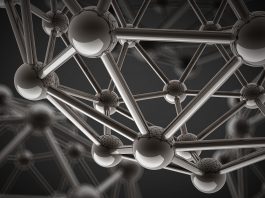Scientists have recently made an important discovery that could help to produce safer and more effective antimicrobial products using graphene. Here, Professor Iseult Lynch and Dr Peng Zhang from the University of Birmingham, who led the research, discuss the findings in more detail.
The thinnest compound known to man at just one atom thick, graphene offers a solution for many applications. In particular, graphene is sought after for medical use due to its thin, lightweight and sustainable properties, as well as its antimicrobial potential.
Recently, an international group of scientists made significant progress towards unlocking graphene’s antimicrobial potential for future use in healthcare applications. The team, made up of scientists from the UK, Cyprus, Austria, Finland, The Netherlands and China, created a series of graphene materials with different surface oxygen contents (SOCs) and compared their antibacterial performance. They discovered that the amount of surface oxygen in graphene materials is a key factor in how effective they could be in killing bacteria. The findings, that were published in ACS nano, could help to inform the design of safer and more effective products to combat antimicrobial resistance.
To find out more about the research and graphene’s antimicrobial potential, The Innovation Platform spoke to Professor Iseult Lynch and Dr Peng Zhang from the University of Birmingham, who led the research.
What potential does graphene have for use in antimicrobial applications?
Graphene has shown great potential for use in antimicrobial applications due to its unique physical and chemical properties. As antimicrobials, graphene materials (GMs) may have advantages over traditional antibiotics due to the nature of their interactions, which are physical – meaning that the graphene sheets wrap around bacteria or use their sharp edges to penetrate the bacteria – rather than being purely molecular mechanisms of action. This physical interaction means that there is less chance of bacteria being able to develop resistance to graphene, as they can to misused antibiotics.
It has been shown that graphene and its derivatives have broad-spectrum antimicrobial potential against various bacteria, viruses, and fungi. Graphene can be used as an antimicrobial agent in many applications, including:
- Antibacterial coatings: Graphene can be used to create antibacterial coatings for surfaces such as medical equipment, food packaging, and textiles. These coatings can prevent the growth of bacteria on surfaces and reduce the risk of infection;
- Wound healing: Graphene has been shown to promote wound healing by accelerating the formation of blood vessels and skin cells. It can also prevent bacterial infection in wounds, reducing the risk of complications; and
- Water purification: Graphene oxide can be used to create filters that remove bacteria and other contaminants from water. These filters are highly effective and have the potential to provide clean drinking water to remote areas.
Can you outline the results of your recent research into graphene’s antimicrobial potential?
Our key finding is that the way in which graphene interacts with bacteria (the interaction mode) is highly dependent on the amount of oxygen at the surface – the surface oxygen content (SOC).
Graphene materials with high SOC predominantly attach flat against (in parallel to) the bacterial cell surface from a suspension. The interaction mode shifts to edge-on (perpendicular) interaction when the SOC reaches a threshold of ~ 0.3 (the atomic percent of O in the total atoms). Such distinct interaction modes are highly related to the rigidity of graphene materials.
Graphene oxide (GO) with high SOC is very flexible and, thus, can wrap around bacteria, while reduced GO (rGO) with lower SOC is much more rigid and so tends to come into contact with the bacteria via their edges.
Neither mode necessarily kills bacteria, but the bactericidal activity depends on the interaction of the graphene materials with surrounding biomolecules suggesting a chemical mechanism also.
These findings suggest that variation of SOC of graphene materials, which determines the degree of rigidity of the materials, is a key factor driving the interaction mode with bacteria, thus helping to understand the different possible physical mechanisms leading to their antibacterial effects. The SOC can be used as a key factor for designing effective antibacterial agents.
What is the significance of the findings?
The fundamental question as to whether the antibacterial potential of GMs originates from parallel interaction or perpendicular interaction, or from a combination of these, has been clarified by this work; both modes contribute to the antimicrobial activity of graphene materials, depending on the surface oxygen content, which affects the rigidity of the material and thus whether it interacts with bacteria edge-ways (rGO with low SOC) or in a side-on manner by wrapping around the bacteria (GO, with high SOC). This finding is significant and revolutionises our understanding of the interaction of graphene with bacteria.
For example, it has often been suggested that large graphene sheets wrap the bacteria while small graphene sheets tend to cut the bacteria with the lateral edge. Our findings demonstrate that sheet size is not the determining factor in the mode of interaction, but rather the rigidity of the sheets, which the SOC of the materials determines.
What could the findings mean for future applications of graphene?
These findings suggest that variation of the SOC of graphene materials is a key factor driving their interaction mode with bacteria. The SOC can be used as a key factor for designing effective antibacterial agents. For example, if graphene is used for wastewater treatment where the organic contents are high, graphene with low SOC, and thus high rigidity, might be used preferentially.

The main reason for selecting graphene with low SOC (rGO) for use in wastewater treatment is that our findings also demonstrated that proteins present in the medium bound to the graphene surface, and reduced or deactivated the antibacterial effects of graphene materials with high SOC and acted as a platform for bacterial growth.
At low SOC, however, the antibacterial activity remained high as there are less sites for proteins to bind to the materials as only the edges allow binding in the low SOC graphene materials. The SOC-induced switching threshold will vary depending on other intrinsic material parameters such as lateral size and thickness – thus, the SOC and switching threshold need to be determined explicitly for the specific graphene materials used in a particular application to optimise the antimicrobial activity under the specific test conditions.
What’s next for your research?
Our next step is to use this finding for different application scenarios. For example, in a membrane for wastewater treatment and for low-cost purification of water as part of our work to support the UN Sustainable Development Goal 6 of Access to Clean Water for all.
We are also exploring the potential to develop wound dressings utilising these materials – specifically targeting burns, where infection is a major problem during healing especially for large area burns. The use of SOC-tailored graphene materials as components of wound dressings offers promise in two ways – promoting cell growth at high SOC and being antibacterial at low SOC.
Similarly, dressings for non-healing injuries, such as diabetic wounds, pressure sores, or venous ulcers could be developed – these represent a crucial healthcare problem because in most clinical cases they gradually become chronic due to ineffective healing procedures.
Please note, this article will also appear in the fourteenth edition of our quarterly publication.









